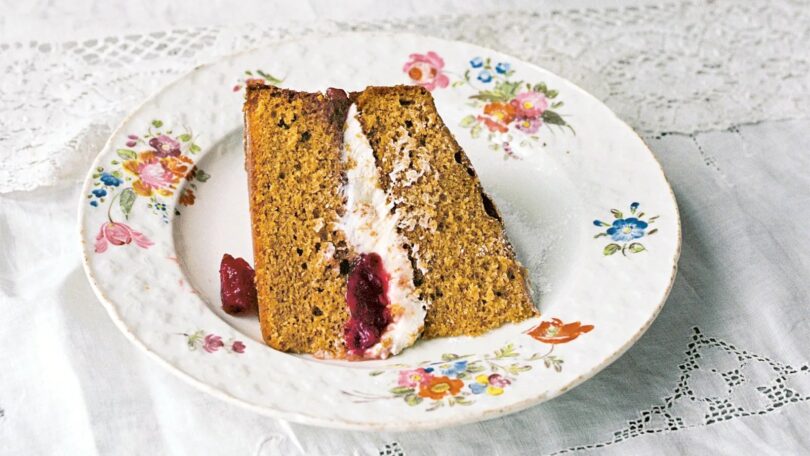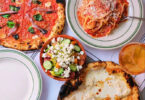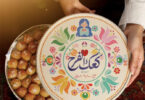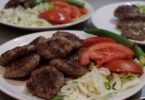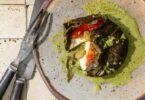Anne Banas
In her small bakery-cafe, Violet Cakes, Claire Ptak brings a California ethos to East London, combining her passion for seasonality and simplicity with English-grown ingredients – a combination that would catch the eye, and taste buds, of royalty.
The American chef, author and food stylist started baking at a young age, working in professional kitchens as soon as she could get a work permit at age 15 in Point Reyes, California. Eventually, she became a pastry chef at Alice Waters’ legendary Chez Panisse restaurant in nearby Berkeley, after impressing the renowned farm-to-table pioneer with a wild huckleberry tart made from foraged fruit for her job trial.
[jump to recipe]Ptak had already embraced Waters’ local foods vision, which she attributes to the “gift” of being from California. She worked at Chez Panisse for three years, and likely would have stayed longer if it weren’t for meeting an Englishman, who convinced her that London’s food scene was “really happening”. By 2005, the pair married and moved to the English capital, where Ptak would later open Violet Cakes in a country-like cottage in Hackney.
When her first cookbook, The Violet Bakery Cookbook, came out in 2015, Ptak sent a copy to Meghan Markle, who ran a lifestyle blog at the time called The Tig. Markle then interviewed Ptak, who clearly left an impression on her. Several years later, according to Ptak, the American actress and her then fiancé, Prince Harry, reached out to her regarding their upcoming wedding, after presumably sampling some of her cakes on the sly. When they met up in person, Markle told Ptak, “It’s not only about who is going to make our cake, but what cake you’re going for make us.” The cake of choice was a relatively unassuming, multi-tiered delight flavoured with Amalfi lemons and an elderflower cordial extracted from flowers harvested at Sandringham House, the late Queen Elizabeth’s private country residence.
In myriad ways, the Californian-turned Londoner was the ideal baker for the Duke and Duchess of Sussex, who as Ptak said, “also cared about the provenance of [local] ingredients”. And not only were Ptak and Markle fellow Californians, but they would joke about how they both moved to London for their English boyfriends. In 2022, Ptak also had the honour of making the couple’s daughter, Lilibet’s first birthday cake – which had the same interior flavours as their wedding cake, but was iced with a princess-like pink strawberry buttercream instead of plain white.
Pink seems to be a theme for Ptak, a self-professed cake lover whose second cookbook, Love is a Pink Cake: Irresistible Bakes for Morning, Noon, and Night (available in the US on 2 May 2023), came together in between pandemic lockdowns. Representing Ptak’s then and now, the new release is really two books in one, with the first half focusing on California and the second on England.
“Everybody loves California and everybody loves England in kind of fairy tale ways, and they have their own idea of what those places are,” said Ptak. “I wanted to just to show my version. We’ve seen a million baking books and I just wanted to make it really personal.”
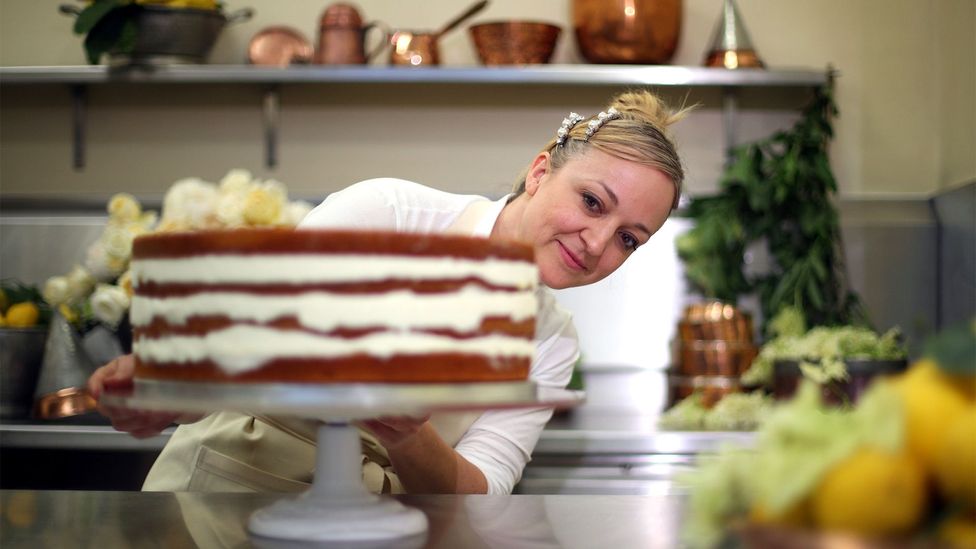
Claire Ptak made an Amalfi lemon and elderflower cake for Harry and Meaghan’s wedding (Credit: WPA Pool/Getty Images)
After becoming acquainted with local English produce and adapting her “California style” to British versions of ingredients like flour and cream (which perform differently in recipes than those in the US), Ptak delved deep into researching classic British chefs and cookery writers. She then riffed on their recipes, applying her passion for seasonality as well as little tweaks to enhance the flavours.
“I’m always interested in elevating the ingredient to be better than it is on its own. That’s really something I think I learned at Chez [Panisse]: how do you bring out the essence of something, [by] not putting in too many ingredients?” she said. “I think so many people are heavy handed with their baking, and so I like to keep it as simple as possible and just elevate the flavour of whatever is the star ingredient.”
Her take on the Victoria sponge, a two-layer cake filled with jam and cream that was a 19th-Century favourite of Queen Victoria, uses brown sugar instead of white because it not only yields a moister cake, but as Patk explained, “works so well” with fruits such as its hero ingredient: strawberries. Ptak also believes that the cake is a “really good example” of her melding of English and Californian styles.
“It’s such a classic, beloved recipe of the English teatime… and [the English] most commonly like a strawberry jam,” said Ptak. “And I’m like, ‘Oh my God, you can do any jam [in] any season… it could be rhubarb, it could be plums, it could be, you know, berries. It could be anything.'”
When it comes to making a great Victoria sponge, Ptak offers a few tips. One is to always bake it at a low temperature for a long time, which results in a “really nice flat top” that is essential for effectively stacking the cake layers neatly. And as someone who detests what she calls “funnel-like puddles of air” in her sponge, Ptak also recommends smacking the cake down on the counter before putting it into the oven.
“I think people are always afraid that they’re going to make a cake fall or collapse. But it’s actually a really good technique to just get out a few of those big air pockets,” she said.
Another thing Ptak says about Victoria sponge is that it’s a very easy cake to make, so long as you weigh your ingredients (versus measuring by volume), since the eggs, flour, butter and sugar all weigh exactly the same (250g, in the case of Ptak’s recipe).
Brown Sugar Victoria sponge recipe
By Claire Ptak
This golden brown, less refined version of Victoria sponge has a wonderful texture. I love it with my quick strawberry jam – strawberries and brown sugar are very good friends. A layer of whipped unsweetened cream in the middle balances out the cake perfectly.
Makes 1×20cm (8in) cake
Serves 8-10
Method
Step 1
First make the jam. Put 125g (3½oz) of the strawberries with half of the sugar into a small heavy-bottomed pot and crush with potato masher (or similar) while warming through over a low heat.
Step 2
Preheat the oven to 180C fan/200C/400F/gas mark 6 and line a roasting tin with baking paper. Put the remaining sugar into the lined roasting tin and bake in the oven for 10-15 minutes to warm through.
Step 3
Add the remaining strawberries and sugar to the crushed strawberries, bringing just to a simmer, then add the warm sugar. The warm sugar keeps the cooking going swiftly so you can cook the fruit as quickly as possible, preserving that fresh fruit taste. Stir until the sugar dissolves, then add the lemon juice. Bring to the boil and allow to bubble away for 12-15 minutes. Cool completely (any leftovers after the cake has been assembled will keep for up to two weeks).
Step 4
Preheat the oven to 150C fan/170C/340F/gas mark 3½ and grease and line two 20cm (8in) cake tins with baking paper.
Step 5
In the bowl of a stand mixer fitted with the paddle attachment, cream the butter and sugar together until pale and fluffy. Beat in the eggs one at a time, beating between each addition and scraping down the sides of the bowl as needed.
Step 6
Whisk the flour, baking powder and salt together, then add this to the mixer and continue to mix just until incorporated.
Step 7
Divide the mixture evenly between the prepared cake tins, then bake on the middle shelf of the oven for 25-30 minutes, or until a skewer inserted in the centre comes out clean. Leave to cool in the tins before turning out.
Step 8
Once the cakes are cool, spread one cake with 150g of the cooled jam. Whip the cream to soft peaks and spoon on top of the jam, then top with the second cake layer. Dust with icing sugar. Chill until ready to serve to keep the cream nice and fresh.
Courtesy: BBC

